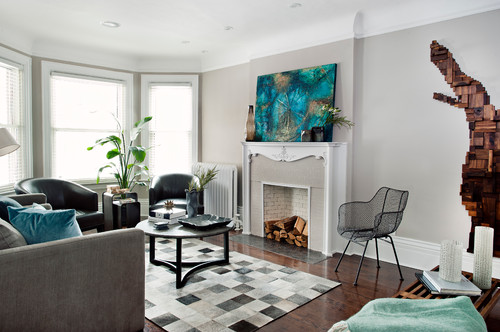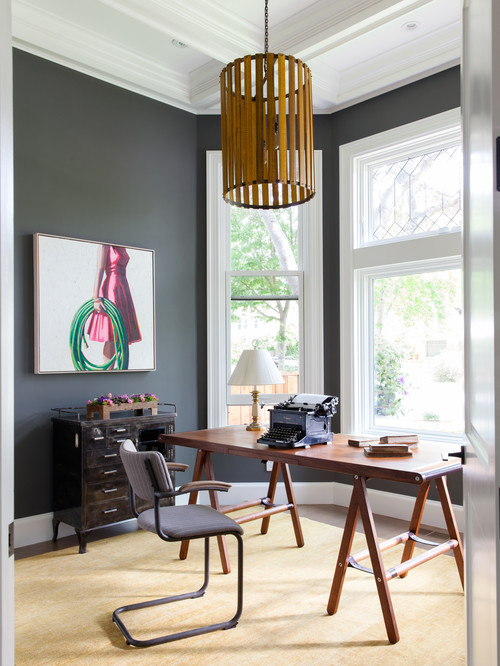When prepping your home for sale, one of the most important tasks is giving your walls a fresh coat of paint. The standard advice from most real estate professionals is to keep them neutral with shades of white. But as a home stager and an interior designer, I prefer to take a more stylish approach. Remember, the overall goal of home staging is to make each room feel fresh, inviting and neutral enough so that prospective buyers can imagine themselves living there. That doesn’t have to translate, however, to bland, boring and devoid of style. Sometimes white can work, but a greater concern is making sure the room doesn’t look too stark. These elegant, crowd-pleasing neutral paint colors can help you stage your home to perfection.
As you consider these choices, keep in mind that to present your home in the right light, you’ll want to select a neutral paint color that coordinates with your furnishings and finishes. The following warm or dark neutrals can add style and while maintaining a mainstream look. Gorgeous ‘Greige’ Gray has been the new white for years now. But not all grays are created equal. “Greige,” a pale gray with a beige undertone, is one of the most versatile colors for staging. Essentially a pale taupe, greige is a cool, sophisticated hue that can elegantly complement and add depth to a mostly white room. It’s great in both large and smaller spaces.
Bird’s Egg Blue I always refer to this type of blue as a grown-up turquoise. A warm medium blue with sunny undertones, bird’s egg blue is an elegant choice for living rooms, bedrooms and bathrooms, particularly when the rest of the room is white, beige or gray. A pale serene turquoise works well with both traditional and modern decor to create a soothing feeling in this room. This calm environment can have a positive emotional effect on potential buyers and allow them to appreciate the beauty of the space.
Dramatic Charcoal A darker color can also be a surprising neutral. Many people might be hesitant to use a dark paint color, thinking it will make the room look smaller or darker. A dark color can, however, add depth on an accent wall. In a dark room it can conceal any shadows and replace an overall dark feeling with a serene and stylish one. Charcoal, a deep gray, is a perfect dark neutral that can raise the style factor in a room as well as add a refreshing cool tone that complements beige and orange wood hues. Adding subdued drama, it works well in light-filled rooms or on an accent wall, especially in smaller rooms or on walls where you want to feature an architectural element. For a stylish contrast, coordinate charcoal walls with accessories and furniture in lighter colors, such as whites and pale beiges.
Golden Yellow Let the sunshine in with a little golden yellow on your walls or fixed elements such as cabinets. This photo shows how a cheerful yellow can add warmth to a mostly white kitchen; it works well with white or stainless steel appliances. Related: Pro Tips for Painting Kitchen Cabinets In other rooms, such as a cozy bedroom or living room, this color’s sunny disposition can add a layer of charm to an otherwise blah color palette. It’s especially helpful in rooms that have low light, no view, or architectural features that cast dark shadows. The golden hues help eliminate a darker feeling and can distract from a bleak view. Look for a yellow that has a slight wheat or creamy undertone and that isn’t overly bright or garish. A mellow yellow coordinates with most wood hues, earth tones, blues and pastel colors.
Classic Navy Navy blue is an excellent paint color to add sophistication, drama and a feeling of refined maturity to a room. Similar to charcoal gray, navy works well in a light-filled room or on a featured accent wall, particularly in smaller rooms or walls with architectural details like a fireplace. Related: Freshen Up an Old Fireplace With Contemporary Fireplace Screens Coordinate navy with contrasting pale hues like whites, silver or beiges. A navy accent wall gives an ordinary room a more designed and notable look. This is a clever design trick to help a room feel a bit larger or appropriately functional to a prospective buyer.
Creamy Whites If your walls are already a shade of white and adding a new color isn’t in your comfort zone, look to neutral creamy whites to give the room a warm and refreshing look. Creamy white has an undertone of pale beige or greige, without being too yellow. The added warmth can give a stark room a welcoming glow without adding color. Pair your creamy white walls with a whiter color on the trim, ceiling and fixtures.
This post was written by Neila Deen, Houzz and posted by RealBird with permission.







Leave a Reply
You must be logged in to post a comment.